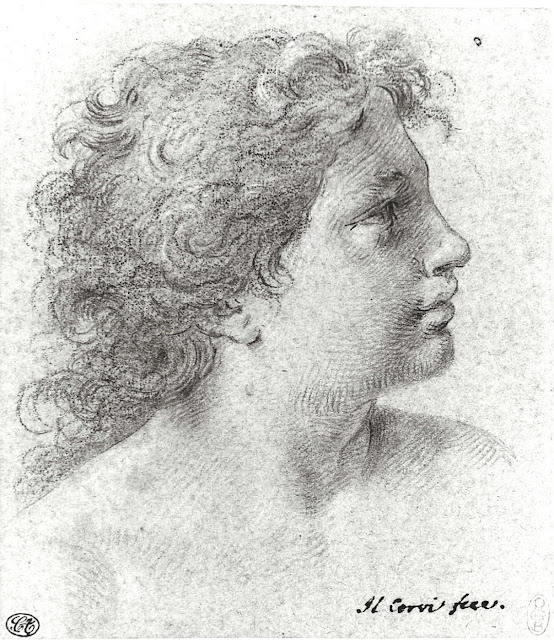 |
| Domenico Corvi Portrait of painter David Allan with statuette of the Borghese Gladiator 1774 oil on canvas National Galleries of Scotland |
 |
| Domenico Corvi Allegory of Painting 1764 oil on canvas Walters Art Museum, Baltimore |
 |
| Domenico Corvi Virgin and Child before 1803 oil on canvas Museum of Fine Arts, Boston |
 |
| Domenico Corvi Aurora flanked by figures of Dawn and Dusk (study for ceiling fresco at Villa Borghese, Rome) 1782 drawing British Museum |
 |
| Domenico Corvi Glorification of Andrea Doria (modello for ceiling fresco at Palazzo Doria, Rome) ca. 1750-68 oil on canvas Minneapolis Institute of Art |
"Domenico Corvi was born in Viterbo in 1721, and was a student of Francesco Mancini in Rome, though he was more strongly influenced by the example of Anton Raphael Mengs and Pompeo Batoni. Corvi was a meticulous draftsman whose academic smoothness and exactitude was respected by Mengs himself, but who was lacking in any personal or vital impulse in the organization or style of his paintings. He possessed little painterly talent and his art characteristically reveals the same tendency toward the use of grey, toneless colors that are typical of his first teacher; he was prone to defend the uniformity of his colors as resulting from his concern for the preservation of his works. His history paintings with artificial lighting effects were highly esteemed and compared to the works of Gerrit van Honthorst. As a teacher, Corvi was among the most important champions of classicism in Rome, though less on the basis of theory (as was the case with Mengs) than with practical instruction in coldly correct drawing based upon the most exact observation of the model. Vincenzo Camuccini and Francesco Landi, the two chief masters in Rome at the beginning of the 19th century, were among his students. Corvi himself, still fully occupied with works for Roman as well as foreign clients, died in Rome in 1803."
– Hermann Voss, from Baroque Painting in Rome (1925), revised and translated by Thomas Pelzel (San Francisco: Alan Wofsy, 1997)
 |
| Domenico Corvi Self-portrait before 1803 oil on canvas Accademia di San Luca, Rome |
 |
| Domenico Corvi Samson and Delilah before 1803 drawing British Museum |
 |
| Domenico Corvi Head of Youth ca. 1770-90 drawing Philadelphia Museum of Art |
 |
| Domenico Corvi Académie ca. 1760-70 drawing Philadelphia Museum of Art |
"Corvi was awarded a first prize for drawing in a competition at the Accademia di San Luca in his adopted city of Rome at age twenty-nine, and in the course of his slowly prospering career as a portraitist and history painter he became known for his astute rendering of the human figure. . . . Drawing from the nude was considered essential training for young artists and was granted official sanction with the founding in 1754 of the Accademia del Nudo in Rome as a subsidiary of the Accademia di San Luca, from whose membership a director was annually chosen. Corvi, who had earlier sponsored his own private teaching academy, was elected to the post in 1757 and then at intervals over the years until his death."
– from curator's notes at the Philadelphia Museum of Art
 |
| Domenico Corvi The Vestal Tuccia before 1803 oil on canvas Pinacoteca Capitolina, Rome |
 |
| Domenico Corvi Camillus and the Schoolmaster of Falerii ca. 1764-66 oil on canvas Pinacoteca Capitolina, Rome |
 |
| Domenico Corvi Sacrifice of Polyxena ca. 1790-1800 oil on canvas Museo Civico, Viterbo |
 |
| Domenico Corvi Two Swiss Guards (study for altarpiece) ca. 1765-70 oil on paper Philadelphia Museum of Art |
 |
| Domenico Corvi St Michael defeating Satan (detail) 1758 oil on canvas Chiesa di Trinità dei Monti, Rome |